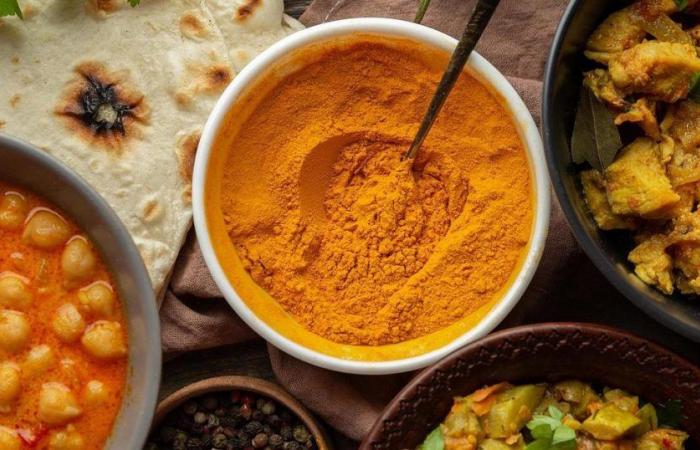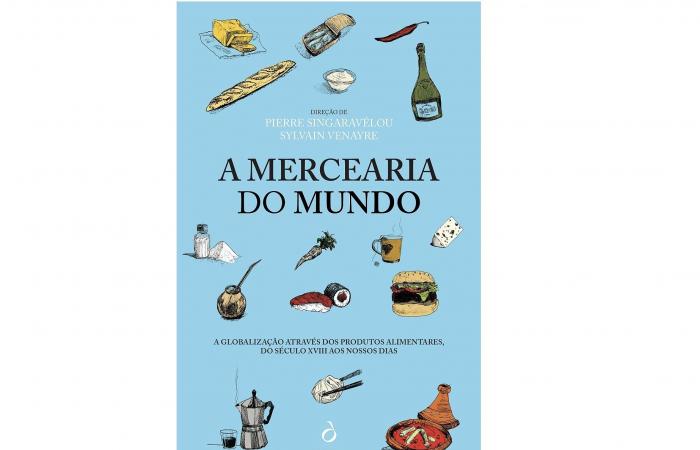The Grocery Store of the World takes us to the traditional stores that, taking us to the end of the street, transport us to the end of the world. And that is the intention of Pierre Singaravélou and Sylvain Venayre, responsible for directing this journey through food products. The book, published by Quetzal and published on March 21st, takes a look at tastes from the 18th century to the present day. Of Sushi to the ramenincluding Port wine, oysters, salt and seasonings, without forgetting the burgers, pizzas and the chili con carnein total there are 88 products that are part of our lives and whose history shows how the globalization of food, flavors and politics is a volatile body, which can be both explained and surprising.
All the first sentences of each chapter include a date and a place: they are the starting point to explain the secrets of each ingredient and how each dish arrived at our table. Pierre Singaravélou (1977) is a French professor (at the Sorbonne and King’s College) who has dedicated himself to colonial empires and the history of globalization. Sylvain Venayre (1970) is a historian, specialist in the 19th century and the representation of time and space in travel (having studied with Alain Corbin, author of History of Rest), is a professor in Grenoble, Paris and New York. In 2020 they published Le Magasin du Mondea history of the world through objects.
In The Grocery Store of the World We publish the excerpt below.
The curry
In 1747, the Englishwoman Hannah Glasse published in one of her famous cookbooks a recipe entitled “How to prepare an Indian curry”, which echoes an ancient tradition. When the Portuguese arrived in India, at the end of the 15th century, they discovered this very typical, and widespread, way of preparing vegetables or meat in a spicy sauce, which they called curry or caree (from Tamil “kari”). The word evolved into “currey” or “curry”, having no relation to the old English word “cury”: the term used in the title of a famous 14th century cookbook, The Form of Curyor The Book of Cookingin modern English, derives from the Middle French “care”, that is, “cook”.
In the 16th century, the Dutch traveler Jan Huygen van Linschoten refers to the use of curry in Goa, in fish dishes, and, in the 17th century, the Italian Pietro della Valle describes it as a broth based on butter, spices, ginger, turmeric and other spices. Edward Terry, chaplain to Ambassador Sir Thomas Roe in India (1615-1619), provides further details regarding the making. According to him, in the Mongolian court, the meat was cut into small cubes, cooked with onion, herbs, roots, ginger, various spices and a little sauce, which made the dish popular with everyone.
It was precisely this sauce, made with a different mix of spices depending on the dish, that won over the taste buds of Westerners, to the point where doubts still remain about the Indian origins of the sauce. curry powder (curry powder) currently sold in grocery stores. Is this curry powder really, as some Indian chefs claim, an invention of the British? Or simply the result of an appropriation of Indian culinary practices by the metropolis? There remains only one certainty: Indian, British or global, curry has undergone so many transformations throughout its gastronomic journey that it no longer has anything to do with the sauce that Portuguese merchants discovered in the late 1490s. Persian influence, through the emperors Mughals, and the addition of chillies brought from South America enriched it. But, without a doubt, it was the British who introduced the most changes, adapting it to their taste buds. Curry was much appreciated by employees of the British East India Company who, in the 18th century, did not hesitate to marry Hindu or Muslim women and adopt some of their customs, whether in clothing or cooking. This mixture of powdered spices thus becomes a commodity for export: upon returning to England, the nawabs — the name given to the British who had lived and worked in India —, nostalgic for Indian flavors, are great consumers of it. However, the conquest of palates was not linear. The great revolt [dos Cipaios] of 1857 against the British East India Company put an abrupt end to the good understanding between the British and Indians. The colonists are reduced to canned salmon, jars of peas and the insipidity of English food.
credits: Freepik/jcomp
” data-title=”The world is addicted to curry. A professor and historian explains why – The world is addicted to curry. A professor and historian explain why – SAPO Lifestyle”>
However, they cannot stay away from curry for long. From now on, curry integrates two culinary worlds with distinct trajectories. When the British add curry powder to their chutneys and pickles, the Indian reaction to these new culinary practices is ambivalent. In Bengal, the first colonized region, the emergence of restaurants and new English dishes makes Indians come out in defense of traditional dishes; however, those new culinary horizons also arouse their curiosity. The first Indian books with curry recipes date back to this time. In 1889, Bipradas Mukhopadhyay, an expert on the subject, stated, in one of his publications, that what the British called Calcutta curry powder — a mixture of coffee, poppy seeds, turmeric, chilli, cumin and salt — there is nothing Indian about it. According to Mukhopadhyay, Europeans learned to cook curry from Jews, and Jews from Muslims. Which doesn’t stop him from presenting curry dishes with lamb, egg, shrimp and other recipes firangi curry (foreign curry). Its indiscriminate use is clearly contrary to the delicacy of Bengali dishes. Curry powder therefore continues to become the essential element of some Anglo-Indian recipes such as mulligatawny soupa chicken broth thickened with rice, or curry rice (rice curry), much appreciated by British colonists.
credits: Quetzal
” data-title=”The world is addicted to curry. A professor and historian explains why – The world is addicted to curry. A professor and historian explain why – SAPO Lifestyle”>
Indians take it to the Caribbean, Fiji, Guyana, the Maldives, Mauritius, Suriname, South Africa and Trinidad. In North America, in the early twentieth century, the arrival of Sikhs from the Punjab to Mexico and Southern California gave rise to the chicken curry enchilada, a cross between Mexican and Punjabi culinary traditions. In New York, consecration arrives when the name Curry Row is assigned to a zone of Manhattan. In Great Britain, thanks to Bengali emigrants from the Sylhet region, curry leaves its small initial circle; in the 1940s, it became so popular among London students that it rivaled fish and chips and hot pies. In the 1960s, many young people consumed curry rice as an accompaniment to beer or after a night at the pub. O Madras curry, less sophisticated, becomes the new watchword. The sale of curry paste It facilitates its use in a wide variety of dishes, in French fries, to flavor dried fruits (sultanas) or with cold chicken and mayonnaise. Many ships of the very traditional Royal Navy even choose it as a Sunday lunch dish on board. More recently, fusion cuisine has integrated it into the ethnic cuisine category.
Curry has also come to be used in many traditional dishes. Germany invented the currywurst, a sausage in curry sauce that has become an icon of Berlin cuisine; Japan, the kare pan, a type of fried donut with curry filling; South Africa, the bunny chow, a bread stuffed with meat and curry; It is one of the ingredients in Singaporean noodles. Is there any country in the world that still doesn’t know it? Southeast Asia has the thai massaman curry or the surprising thai curry pizza, and in Réunion, Jamaica and Nigeria, curry dishes are the national pride. In the Japanese archipelago, where it was imported from England in the 19th century, it added flavor to rice in dishes such as frog curry and began to be sold in small sachets. Nowadays, the importance of curry in Japan is similar to that of hamburgers in the United States.
More recently, curry returned to India, now as a British product. Here is a new form of gastronomic imperialism! In 2010, the curry was presented at the festival Taste of Britain, in Calcutta, as one of the fifty typically British dishes. At the same time, in Great Britain, the National Curry Weekwith the title “City of Curry” being disputed by cities such as London, Newcastle or Birmingham — very proud of its specialty, the balti currya dish prepared in a small wok called balti. Although it does not claim to have medicinal properties, curry can also help with difficult revelations, as in the film The Fish Curry (2017), directed by Abhishek Verma, in which a son decides to prepare his father’s favorite dish, a fish curry, in the hope that it will help him accept his coming out.
In the face of all these appropriations, curry has acquired a strong national feeling for Indians, and they denounce the forms of dispossession resulting from commercial practices, such as the relocation of basmati rice cultivation to California or the appropriation of turmeric. by foreign pharmaceutical companies. No Indian who respects traditions uses the curry power industrial, cry out chefs Indians: true curry is a specific mixture, adapted to each dish and used according to precise methods. Therefore, in India, there are thousands of curries which are in no way similar to the generic powder sold worldwide.
After Britain, the world today became “curryholic”, far beyond the imperial space where curry initially spread. The countless appropriations separated it from national traditions, ancestral practices, a terroir. Despite the appeals of Indian chefs eager to claim its authenticity and thus integrate it into the soft power Indian, curry embodies the ongoing miscegenation in a globalized post-colonial world. Its global success should justify its recognition as a Cultural Heritage of Humanity.
Tags: world addicted curry professor historian explain Current Affairs
--






